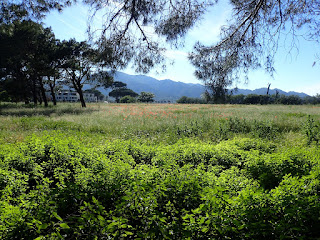After our ascent of Mt Occi
to visit the deserted village, we set off again for our next planned stop-over
en route to Cap Corse; St Florent, using our Campercontact app to find a couple
of likely camp sites near-by.
We could see on the map that
we could go across le dèsert Agriates, an area described as once being the
breadbasket of northern Corsica but now reduced to a barren, treeless and
denuded landscape (according to our 10 year old Rough Guide). Always up for a
driving challenge, we made sure we had plenty of fresh water, that the van’s
vitals were in good order, and we had enough daylight to do the drive safely.
The coastal road to get to
the desert was the by now customary Corsican caper, with lots of bends, narrow roads
(especially on blind corners) and stunning views across the many bays and coves
that dot the coastline, with what we took to be the start of the desert and
barren hillsides away in the distance.
As we turned off the ‘main’
road to the white, wiggly, switch-back route across the desert, we were
beginning to wonder whether we’d taken a wrong turn, as one green valley
followed by green hill-side, was replaced with another…
And so, with our emergency
water rations untouched and our kepis stowed for another day, we found
ourselves on the edge of St Florent having barely broken a sweat. Clearly much
has improved for the Agriates desert since our Rough Guide was penned!
Camping Kallisté was the
first of the sites from our app to greet us and, if the app was to be believed,
offered an ACSI discount even though we couldn’t find it on our ACSI app or in
the ACSI booklet. And sure enough, it did, and so we were soon tucked away on a
very pleasant pitch and able to get our mat out to dry off after its drenching
in Calvi! The site was set back from the beach west of St Florent and separated
from it by a large meadow, full of flowers and the buzzing of insects.
With time on our side, we
decided to have a stroll into St Florent, a 15 minute walk along the beach
according to reception, but with what looked like a harbour entrance on our Google
map to swim across, so we took a 30 minute walk along the road instead. And as
we arrived into the outskirts of the town, we noticed a footbridge across to
the beach that Google had yet to find…
The town itself is a
pleasant mix of bars, cafés, restaurants and boat hire firms, not yet busy
enough to become the touristic maelstrom it would no doubt be in high season.
For now though, it allowed us a relaxed stroll past one menu board after
another, with hastily adjusted prices being stuck up on paper across the
blackboards as restaurants jockeyed with each other to tempt the passing trade!
A stroll along the harbour
arm past the small working fishing boat section and with views back to the
Genoese tower (renovated after being reduced to rubble by Nelson in 1794), allowed
us to look back to the beach that our campsite was on and we determined to
check out the bridge and use it on our way back – a much prettier and direct
route for sure!
The beach was interesting in
that it was no more than a spur of sand that had been thrown up over the years,
allowing it to form a bar across what would have once been a wider estuary, and
on this occasion (as with many of the other Corsican beaches on this trip) covered
in banks of drying Posidonia Oceanica weed (or sea grass) – and lest we were
minded to have a bit of a moan ‘a les rosbifs’, the local authorities had
helpfully erected a large sign pointing out all the eco benefits of Posidonia to
the fish stocks of the region (indeed the Italians call its fruit the ‘olive of the
sea’). Notwithstanding its eco credentials, and that it is in decline in the
Mediterranean, it has certainly taken the gloss off some of the Corsican beaches
we have seen when compared to the pictures without the weed/seagrass!
And although we had braced
ourselves for a potentially noisy night having seen a number of ‘disco bars’
along the harbour, we were clearly early enough in the season to have escaped
them and awoke after a peaceful night to a sunny day and our next road trip
adventure – Cap Corse along the Napoleonic corniche road…
S&J

















































